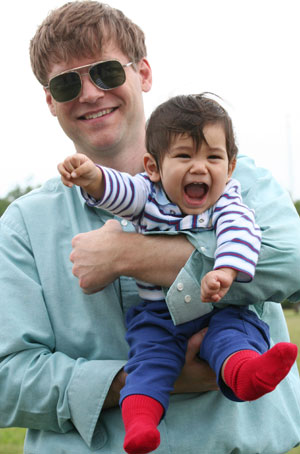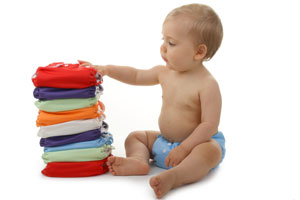New and expectant parents are faced with a mountain of decisions. Breast-feeding or formula? Home care or daycare? And then you have the diaper dilemma. For many, it’s tough to decide between the two basic choices; disposable or cloth. However, there is a third option you might not have heard about. There is a growing movement of North American parents who are choosing to use no diapers at all. They are advocates of the elimination communication method (Also known as infant potty training, natural infant hygiene and potty whispering). Followers of this method say that you can start training your baby to use the potty almost from birth.
 The idea of leaving your child diaperless might sound strange, even horrifying to our ears, but it’s not a new concept at all. In fact, about 50% of the world’s children never wear diapers and are fully potty-trained by the time they are a year old. In China, for example, children wear special split-bottom pants, so when a parent sees that her child needs to “go,” she can immediately take him to an appropriate location.
The idea of leaving your child diaperless might sound strange, even horrifying to our ears, but it’s not a new concept at all. In fact, about 50% of the world’s children never wear diapers and are fully potty-trained by the time they are a year old. In China, for example, children wear special split-bottom pants, so when a parent sees that her child needs to “go,” she can immediately take him to an appropriate location.
Advocates for elimination communication rely on their infant’s body language, timing and verbal cues. Parents will turn to elimination communication for a number of reasons, often because it is more environmentally friendly or a less expensive choice than diapers. Advocates also claim that babies are more comfortable without diapers (no diaper rash) and that being attuned to their child’s needs will create a higher level of parent-child bonding. According to Laurie Boucke, who has written two books on the subject, children are usually “toilet-independent” or potty trained by age 2 when using the elimination communication method.
So, how do you go about training a very young baby to use the potty? Do you have to hover around your child 24 hours a day to prevent accidents? And what happens when you’re stuck in traffic and your diaperless infant needs to “go”? Let’s delve a little deeper into the process to find out!
Key Factors to Elimination Communication Success
- Look for Signals: The first step towards success with elimination communication is learning how to interpret your baby’s body language. Followers of elimination communication believe that parents are able to do this right from birth. Although very young infants may not be able to verbally communicate their need to empty their bowels or bladder, they will give you signals. These signs could be grunting before a bowel movement or squirming before urination. The parent’s responsibility is to read these signals and then hold baby over the potty or toilet.
- Learn your Baby’s Schedule: Once you have had some time to study your infant’s signals, it’s fairly simple to figure out your baby’s elimination schedule. Most babies do go at regular intervals during the day, and a certain number of minutes after waking up or eating. After a while, parents can usually predict with strong certainty when their children will need to go to the potty even before they start doing their little dances!
- Use Verbal Cues: This is where the “communication” part comes in. When baby communicates her need to you, you will then communicate a special sound to her, often one that mimics the sound off pee going into the toilet. (usually an “ssss” or “shhh” sound) as she’s using the potty. Once a baby makes the connection between the sound and the experience of peeing or pooping, the sound can help trigger a bodily response at potty time, if needed.
- Be Flexible: You can customize elimination communication to the needs of your family. Your infant will not have to be diaper-free at all times, and you won’t jeopardize your baby’s success if you put her in a diaper overnight or on a long car trip. Adding flexibility to this (or any other method of potty training) will go a long way for making it a positive experience for both you and your child!
Infant potty training experts will say it’s best to start training before the baby is 6 months old. After that, it’s still possible, but the child will be used to wearing diapers and will have a harder time learning new habits.
So, what do doctors and traditional potty training experts think about the elimination communication method? The American Academy of Pediatrics says that babies cannot fully control their bladder or bowel movements until they’re about 18 months old, so that’s when they suggest parents should begin potty training. The infant potty training community does beg to differ, however. They use the babies in China as an example to argue that children can – and do – gain control at an earlier age. We too have talked to some parents who use elimination communication, and they have told us that they are successfully completing potty training their children between 12 and 24 months of age.

So, is this the right approach for you and your family? As you can see, there is much food for thought on the subject. It will take a lot of time and patience, but more time and patience than changing diapers for three years? Only you can be the judge!
**Sources:
Cooper, Alison. “What is elimination communication?” 27 February 2008. HowStuffWorks.com.https://lifestyle.howstuffworks.com/family/parenting/babies/elimination-communication.htm 02 December 2011.
American Academy of Pediatrics. healthychildren.org “Toilet Training.” https://www.healthychildren.org/English/ages-stages/toddler/toilet-training/Pages/default.aspx
•Infant Potty Training. BabyCenter.com https://www.babycenter.com/0_infant-potty-training-what-it-is-and-how-to-do-it_1745035.bc
•Schmitt, Barton D. “Toilet Training: Getting it Right the First Time.” Contemporary Pediatrics, May 1, 2004.

Pingback: Potty Training Around the World | Potty Time Blog
Pingback: Potty Training Around the World | Potty Time Blog
I am sorry. That sdunos frustrating! Kudos to you for recognizing your daughters readiness at such an early age. It’s not always easy to do. I just posted an article to answer your question. You’ll find it .Emily